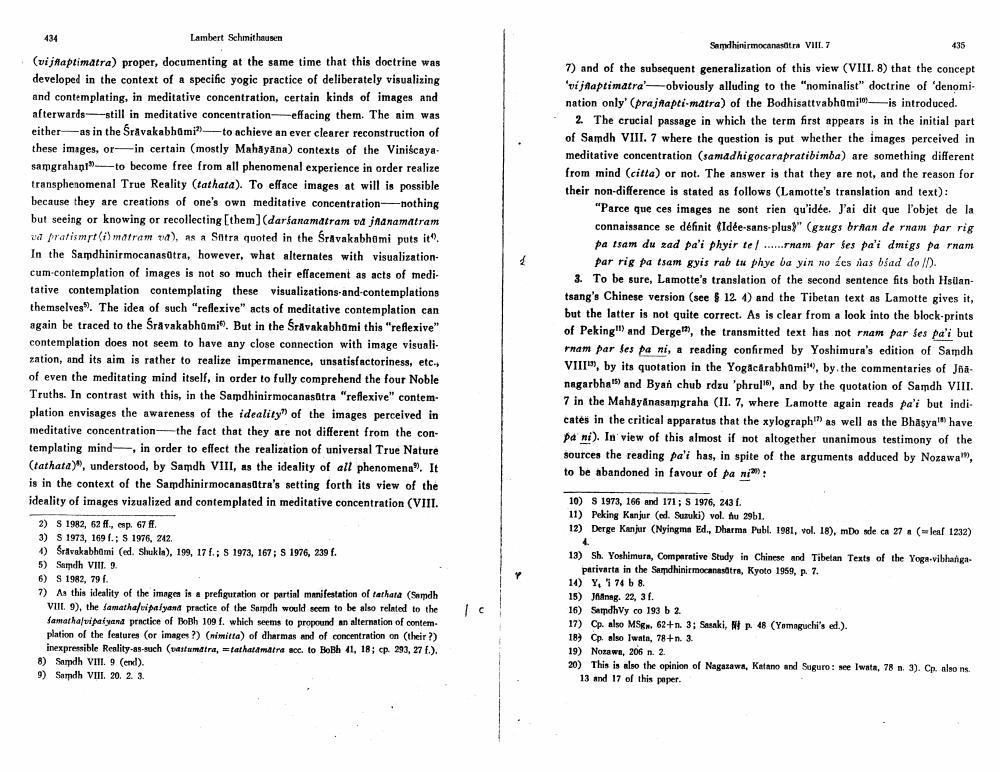Book Title: On Vinaptimatra Passage In Samadhinirmocanasutra VIII Author(s): L Schmithausen Publisher: L Schmithausen View full book textPage 2
________________ Samulinermocanastra VII 7 435 434 Lambert Schmithausen (vijfaptimatra) proper, documenting at the same time that this doctrine was developed in the context of a specific yogic practice of deliberately visualizing and contemplating, in meditative concentration, certain kinds of images and afterwards still in meditative concentration effacing them. The aim was either as in the Sravakabhomi—to achieve an ever clearer reconstruction of these images, or in certain (mostly Mahayana) contexts of the Viniscaya. samgrahap -to become free from all phenomenal experience in order realize transphenomenal True Reality (tathata). To efface images at will is possible because they are creations of one's own meditative concentration-nothing but seeing or knowing or recollecting [them)(darfana matramvaj nanamatram w pratism (i) matram ), as a Satra quoted in the Sravakabhomi puts it's In the Samdhinirmocanastra, however, what alternates with visualization cum contemplation of images is not so much their effacement as acts of meditative contemplation contemplating these visualizations and contemplations themselves. The idea of such "reflexive" acts of meditative contemplation can again be traced to the Sråvakabhim. But in the Sravakabha mi this "reflexive" contemplation does not seem to have any close connection with image visualiration, and its aim is rather to realize impermanence, unsatisfactoriness, etc.. of even the meditating mind itself, in order to fully comprehend the four Noble Truths. In contrast with this, in the Samdhinirmocanastra "reflexive" contem plation envisages the awareness of the ideality of the images perceived in meditative concentration the fact that they are not different from the contemplating mind in order to effect the realization of universal True Nature (tathata), understood, by Samdh VIII, as the ideality of all phenomena". It is in the context of the Samdhinirmocanastra's setting forth its view of the ideality of images vizualized and contemplated in meditative concentration (VIII. 7) and of the subsequent generalization of this view (VIII. 8) that the concept 'vijnaptimatra- obviously alluding to the "nominalist" doctrine of 'denomi. nation only' (prajnapti-matra) of the Bodhisattvabhominis introduced. 2. The crucial passage in which the term first appears is in the initial part of Sandh VIII. 7 where the question is put whether the images perceived in meditative concentration (samadhi gocarapratibimba) are something different from mind (citta) or not. The answer is that they are not, and the reason for their non-difference is stated as follows (Lamotte's translation and text): "Parce que ces images ne sont rien qu'idée. J'ai dit que l'objet de la connaissance se définit (Idée-sans-plus)" (grugs brilan de ruam par rig pa sam du tad pa'i phyir tel .....nam par ses pa'i dmigs pa nam par rig pa sam gyis rab tu phye ba yin no les das bsad do ID. 3. To be sure, Lamotte's translation of the second sentence fits both Hsuantsang's Chinese version (see $ 12. 1) and the Tibetan text as Lamotte gives it, but the latter is not quite correct. As is clear from a look into the block prints of Peking") and Derget, the transmitted text has not ram par ses pa'i but rnam par les pa ni, a reading confirmed by Yoshimura's edition of Samdh VIII", by its quotation in the Yogackrabhami, by the commentaries of Jha nagarbha") and Bynh chub rdzu 'phrul!), and by the quotation of Samdh VIIL 7 in the Mahayanasamgraha (II. 7, where Lamotte again reads pa'i but indi cates in the critical apparatus that the xylograph as well as the Bhasyal have pa ni). In view of this almost if not altogether unanimous testimony of the sources the reading pa'i has, in spite of the arguments adduced by Nozawa, to be abandoned in favour of pa ni: 10) S 1973, 166 and 171 ; S 1976, 243 1. 11) Peking Kanjur (ed. Suzuki) vol. Au 2961. 12) Derge Kanjur (Nyingma Ed, Dharma Publ. 1981, vol. 18), mDesde an 27 ( leaf 1232) 2) S 1982, 62 f, esp. 67 f. 3) S 1973, 169 I.; S 1976, 242. 1) Sravakabhomi (ed. Shukla), 199, 171.; S 1973, 167; S 1976, 239 f. 5) Samdh VIII. 9. 6) S 1982, 79. 7) As this ideality of the image is prefiguration or partial manifestation of tathata (Samdh VUIL 9), the famathalipayand practice of the Samdh would seem to be also related to the Samathawi Malyand practice of t h 109 f. which seems to propound an alternation of contemplation of the features (or images?) (nimitta) of dharmas and of concentration on their ?) sible Reality-as-such ( stomatra, =tathatamate acc. to BoBh 41, 18; p. 293, 27 f.). 8) Samdh Vill. 9 (end). 9) Samdh VIII. 20. 2. 3. 13) Sh. Yoshimurn, Comparative Study in Chinese and Tibetan Texts of the Yoga-vibhang parivarta in the Samdhinir mocanastra, Kyoto 1959, p. 7. 11) Y, 174 b 8. 15) Janeg. 22, 31. 16) Sampdhvy co 193 b 2 17) Cp. also MS n. 62+n. 3; Sasaki, p. 48 (Yamaguchi's ed.). 189 Cp. also Iwata, 78+n. 3. 19) Nozawa, 206 n. 2. 20) This is also the opinion of Nagasawa, Katano and Suguro! Me Iwata, 78 . 3). Co also ns. 13 and 17 of this paper.Page Navigation
1 2 3 4 5 6 7 8 9 10 11 12
